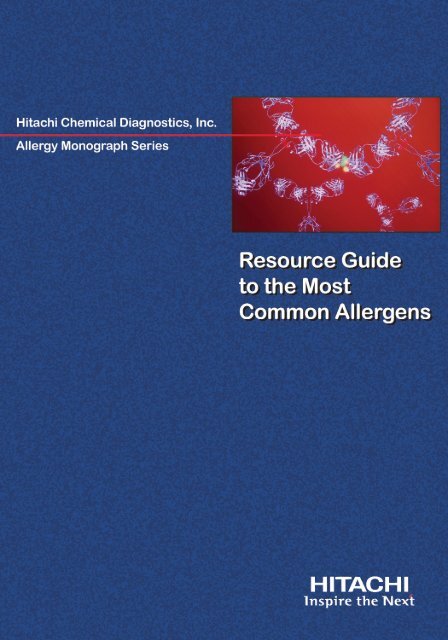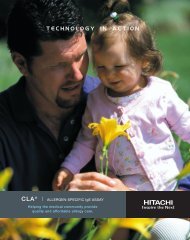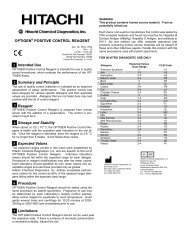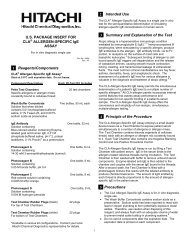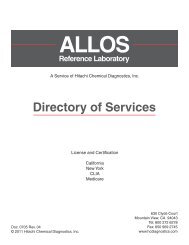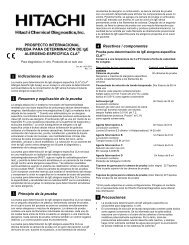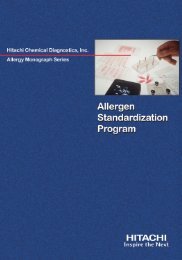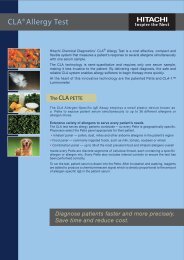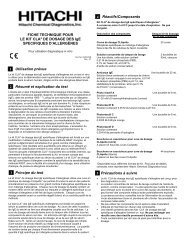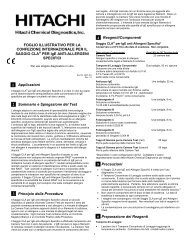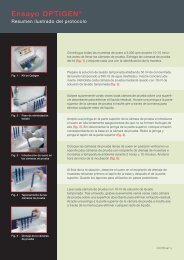Allergen Resource Guide - Hitachi Chemical Diagnostics
Allergen Resource Guide - Hitachi Chemical Diagnostics
Allergen Resource Guide - Hitachi Chemical Diagnostics
Create successful ePaper yourself
Turn your PDF publications into a flip-book with our unique Google optimized e-Paper software.
What is the CLA ® Allergy Test?<br />
<strong>Hitachi</strong> <strong>Chemical</strong> <strong>Diagnostics</strong>' patented CLA chemiluminescent assay technology uses a serum<br />
sample and a Pette to simultaneously assay up to 36 of the most common allergens in a specific<br />
geographic area. The Pette is a disposable device that contains cellulose threads, each bound<br />
with a different allergen or mix of allergens. Patient serum antibodies bind to the specific allergens<br />
on the threads. An enzyme-labeled anti-immunoglobulin antibody binds to the patient's antibody.<br />
CLA's photoreagent system, when combined with the bound conjugate, gives off a chemiluminescent<br />
signal that is read by the CLA -1 Luminometer reporting semi-quantitative results.<br />
What is <strong>Hitachi</strong> <strong>Chemical</strong> <strong>Diagnostics</strong>' In-house <strong>Allergen</strong> Standardization Program?<br />
In vitro allergy tests are dependent on the quality of the extracts employed. The in-house<br />
<strong>Allergen</strong> Standardization Program allows <strong>Hitachi</strong> <strong>Chemical</strong> <strong>Diagnostics</strong> to develop a scientifically<br />
well-characterized product. <strong>Allergen</strong> containing materials are usually a mixture of various proteins<br />
as well as carbohydrates. Patients can be allergic to either major, minor or both allergenic<br />
components. Only a small number of the most common extracts are standardized and characterized<br />
by major and minor allergens. Most allergenic extracts are not uniformly characterized or<br />
standardized and are subject to great variability in product quality. To assure consistency,<br />
safety and diagnostic efficacy, detailed knowledge of the quantity and composition of allergens,<br />
preferably major, and when possible, minor, are the best guarantee.<br />
<strong>Hitachi</strong> <strong>Chemical</strong> <strong>Diagnostics</strong> uses different techniques and methodologies in allergen standardization<br />
to optimize the quality. The purpose of standardizing and characterizing allergens employed in<br />
the CLA Allergy Test is to ensure a consistent presence of the allergenic components on the<br />
solid phase of the CLA system.<br />
The Program has also aided in the understanding of allergens that have not been studied in<br />
detail and for which information on allergenic proteins was not previously available. It is now<br />
possible to provide reproducible lots of the most common allergenic extracts that retain all<br />
allergenic proteins, and when needed exclude irrelevant materials under conditions that<br />
preserve the biological activity.<br />
To ascertain this consistency and reproducibility, each lot is compared to the blueprint of the<br />
established in-house allergen reference standard. A file with detailed information for each<br />
allergen is completed for each allergen reference standard. This file is then made available to<br />
<strong>Hitachi</strong> <strong>Chemical</strong> <strong>Diagnostics</strong>' Manufacturing group as a quick and easy reference for manufacturing<br />
standardized allergens. Upon completion of the standardization of each allergen, a multifunctional<br />
team assures transfer and implementation to Manufacturing and Quality Assurance.<br />
To date, more than 50 of the most common allergens in the world have completed the standardization<br />
program. This brochure contains information regarding those allergens. Results for the field<br />
and in-house clinical studies are reported in comparison to Pharmacia ® CAP. For more<br />
information about the methods used, see <strong>Hitachi</strong> <strong>Chemical</strong> <strong>Diagnostics</strong>' Monograph, "<strong>Allergen</strong><br />
Standardization Program."<br />
Why is <strong>Allergen</strong> Standardization so Important?<br />
The allergen can be one of the major sources of discrepancy in the results between different<br />
in vitro diagnostic tests and skin testing and is also one of the main sources of reproducibility<br />
problems between lots. By standardizing its allergens in-house, <strong>Hitachi</strong> <strong>Chemical</strong> <strong>Diagnostics</strong><br />
gives the clinical laboratory and referring physicians the best opportunity to obtain reliable and<br />
reproducible results.
<strong>Allergen</strong><br />
Dust Mites<br />
Mite (D1, D2)...................................<br />
House Dust (H2)...............................<br />
Epithelium<br />
Cat Dander (E1)...............................<br />
Horse Dander (E3)...........................<br />
Cow Dander (E4)..............................<br />
Dog (Dander/Hair) (E5)....................<br />
Feather Mix (N/A).............................<br />
Foods<br />
Egg White (F1).................................<br />
Milk (Cow) (F2).................................<br />
Wheat (F4)........................................<br />
Corn (Maize) (F8).............................<br />
Rice (F9)...........................................<br />
Peanut (F13).....................................<br />
Soybean (F14)..................................<br />
Crab (F23)........................................<br />
Shrimp (F24).....................................<br />
Tomato (F25)....................................<br />
Pork (F26).........................................<br />
Beef (F27).........................................<br />
Carrot (F31)......................................<br />
Potato (F5).......................................<br />
Tuna (Yellow Fin) (F40)....................<br />
Salmon (Atlantic) (F41).....................<br />
Strawberry (F44)...............................<br />
Apple (Golden Delicious) (F49)........<br />
Egg Yolk (F75)..................................<br />
Casein (F78).....................................<br />
Cheddar Cheese (F81).....................<br />
Chicken (F83)...................................<br />
Celery (F85)......................................<br />
Banana (F92)....................................<br />
Peach (F95)......................................<br />
Squash Mix (N/A).............................<br />
Clam (F207)......................................<br />
Mushroom (F212).............................<br />
<strong>Resource</strong> <strong>Guide</strong> to the Most Common <strong>Allergen</strong>s<br />
Table of Contents<br />
Page<br />
1<br />
2<br />
3<br />
3<br />
3<br />
4<br />
4<br />
5<br />
5<br />
6<br />
6<br />
6<br />
7<br />
7<br />
7<br />
8<br />
8<br />
8<br />
9<br />
9<br />
10<br />
10<br />
10<br />
11<br />
11<br />
12<br />
12<br />
13<br />
13<br />
14<br />
14<br />
14<br />
15<br />
15<br />
15<br />
<strong>Allergen</strong><br />
Grasses<br />
Sweet Vernal (G1)............................<br />
Bermuda Grass (G2)........................<br />
Timothy Grass (G6)..........................<br />
Kentucky Blue Grass (G8)................<br />
Rye, Cultivated (G12).......................<br />
Inhalants<br />
German Cockroach (I6)....................<br />
Cockroach Mix (N/A)........................<br />
(American and German)<br />
Ragweed Mix I (N/A).........................<br />
Molds<br />
Penicillium (M1)................................<br />
Cladosporium (M2)...........................<br />
Aspergillus (M3)................................<br />
Candida (M5)....................................<br />
Alternaria (M6)..................................<br />
Trees<br />
Box Elder (T1)..................................<br />
Black Alder (T2)................................<br />
White Birch (T3)................................<br />
Hazelnut (T4)....................................<br />
American Beech (T5)........................<br />
Mountain Cedar (T6)........................<br />
London Planetree (T11)....................<br />
Weeds<br />
Short Ragweed (W1)........................<br />
Giant Ragweed (W3)........................<br />
Mugwort (W6)...................................<br />
English Plantain (W9).......................<br />
Lamb's Quarters (W10)....................<br />
Burning Bush (W17).........................<br />
Pellitory, Wall (W21).........................<br />
Page<br />
16<br />
16<br />
16<br />
17<br />
17<br />
18<br />
18<br />
18<br />
19<br />
19<br />
19<br />
20<br />
20<br />
21<br />
21<br />
21<br />
22<br />
22<br />
22<br />
22<br />
23<br />
23<br />
23<br />
24<br />
24<br />
24<br />
25
<strong>Resource</strong> <strong>Guide</strong> to the Most Common <strong>Allergen</strong>s<br />
Common Name: Mite<br />
Latin Names: 1- Dermatophagoides pteronyssinus (D1)<br />
2- Dermatophagoides farinae (D2)<br />
Description: House dust mites of the genus Dermatophagoides are associated with<br />
symptoms of asthma and rhinitis. Three species, D. pteronyssinus,<br />
D. farinea and D. microceras are recognized as important allergen<br />
sources in house dust.<br />
<strong>Allergen</strong>ic proteins of mites (with molecular weight):<br />
Mite <strong>Allergen</strong>s MW (kDa) Function IgE binding frequency (% sera)<br />
Der 1 25 cysteine protease 80 - 100<br />
Der 2 14 probably lysozyme 80 - 100<br />
Der 3 28 - 30 Trypsin 70 - 100<br />
Der 4 60 Amylase 40<br />
Der 5 14 40<br />
Der 6 25 Chymotrypsin 40<br />
Der 7 22, 26, 28 40<br />
Der 8 Glutathione transferase N/A<br />
Der 9 Collagenolytic serine prot. N/A<br />
Der 10 36 Tropomyosin N/A<br />
Der 14 Apolipophorin like protein N/A<br />
However, the most commonly and strongly bound allergens are Group I and Group II.<br />
1-Group I of major mite allergens have been isolated, which includes Der p 1, Der f 1<br />
and Der m 1. These allergens have the same MW (24 kDa) and are structurally<br />
homologous. The cDNA and sequence analyses suggest that group I allergens are<br />
proteases. These proteins are heat labile and pH sensitive and predominantly extracted<br />
in mite feces.<br />
2-Group II of major allergens are Der p 2, Der f 2 and Der m 2 with the MW of 14 to 15<br />
kDa. In contrast with Group I allergens, Group II proteins are heat stable and pH<br />
resistant and their physiological function is unknown. Studies showed Group I (25 kDa)<br />
found 32 times more than Group II in mite feces. The ratio of Group I to the Group II in<br />
the air is about 1.5:1 and in dust is 2:1. Group I allergens from dust mites only become<br />
airborne during disturbance and fall rapidly; which is in keeping with their being carried<br />
on fecal pellets.<br />
1<br />
(Continued on next page.)
(Continued from previous page.)<br />
<strong>Resource</strong> <strong>Guide</strong> to the Most Common <strong>Allergen</strong>s<br />
In-House Clinical Evaluation Results:<br />
Mite pteronyssinus (D1):<br />
Sensitivity: 88% Specificity: 100%<br />
Efficiency: 95% Number of Samples: 85<br />
In-House Clinical Evaluation Results:<br />
Mite farinae (D2):<br />
Sensitivity: 91% Specificity: 100%<br />
Efficiency: 96% Number of samples: 80<br />
<strong>Allergen</strong>ic proteins for mite farinae (with molecular weight):<br />
Mite <strong>Allergen</strong>s MW (kDa) Function<br />
Der f 1 25<br />
Der f 2 14<br />
Der f 3 30<br />
Der f 10 tropomyosin<br />
Der f 11 98 paramyosin<br />
Der f 14 apolipophorin<br />
House Dust (H2)<br />
House dust is a complex mixture of allergens such as mold, dander, mite and<br />
cockroach collected from houses. <strong>Hitachi</strong> <strong>Chemical</strong> <strong>Diagnostics</strong> uses extracts from<br />
Hollister-Stier Lab as raw material for this allergen. While mite is considered a<br />
major component of house dust, it is not a major component in this extract.<br />
In-House Clinical Evaluation Results:<br />
House dust (H2):<br />
Sensitivity: 100% Specificity: 100%<br />
Efficiency: 100% Number of Samples: 27<br />
Note: House dust 1 (H1) is supplied by Greer. <strong>Hitachi</strong> <strong>Chemical</strong> <strong>Diagnostics</strong> does not use this extract.<br />
2
<strong>Resource</strong> <strong>Guide</strong> to the Most Common <strong>Allergen</strong>s<br />
Common Name: Cat Dander<br />
Latin Name: Felis domesticus<br />
NCCLS Code: E1<br />
Description: Allergy to cat is a common cause of asthma and rhinitis. The major<br />
allergen in cat dander is a heterodimeric protein, which is composed of<br />
two disulfide chains. The major cat allergen is termed Fel d 1. About<br />
10-15 percent of cat allergic patients are also allergic to cat albumin.<br />
Patients who are sensitized to albumin also react to Fel d 1. <strong>Allergen</strong>s<br />
are present in cat hair as well as cat salivary and lachrymal glands, skin<br />
sebaceous glands, and skin sebaceous gland cells.<br />
<strong>Allergen</strong>ic Proteins (with molecular weight):<br />
Fel d 1 at 38 kDa; two disulfide chains at 4 kDa and 14 kDa<br />
In-House Clinical Evaluation Results:<br />
Sensitivity: 92% Specificity: 94%<br />
Efficiency: 93% Number of Samples: 86<br />
Common Name: Horse Dander<br />
Latin Name: Equus caballus<br />
NCCLS Code: E3<br />
Description: Exposure to horse dandruff is a well-known cause of allergic asthma<br />
and rhinitis. Studies show that patients react mostly to horse dandruff,<br />
serum proteins or both. Major horse proteins are found in hair or dander<br />
and epitheliums.<br />
<strong>Allergen</strong>ic Proteins (with molecular weight):<br />
Equ c 1; lipocalin at molecular weight 25 kDa<br />
Equ c 2 (Antigen #6); lipocalin at molecular weight of 19 kDa<br />
In-House Clinical Evaluation Results:<br />
Sensitivity: 90% Specificity: 100%<br />
Efficiency: 92% Number of Samples: 12<br />
Common Name: Cow Dander<br />
Latin Name: Bos taurus<br />
NCCLS Code: E4<br />
Description: Allergy to cow is becoming rare. Today, cow allergy is often work or<br />
environmental related. Cow dander, the hair and skin, is an important<br />
source of potent allergens responsible for allergic symptoms. Two major<br />
allergens have been identified: Bos d 1 and Bos d 2 plus several<br />
additional ones.<br />
<strong>Allergen</strong>ic Proteins (with molecular weight):<br />
Bos d 4; alpha-lactalbumin at14.2 kDa; Bos d 5 beta-lactoglobulin at 18.2 kDa;<br />
Bos d 2 (Antigen #3), lipocalin at 20 kDa; 22 ~ 25 kDa (Bos d1, Bos d2);<br />
35 ~ 40 kDa; 41 - 46 kDa; Bos d 6, serum albumin at 67 kDa; Bos d 8, caseins<br />
at 20-30 kDa<br />
In-House Clinical Evaluation Results:<br />
Sensitivity: 95% Specificity: 83%<br />
Efficiency: 93% Number of Samples: 27<br />
3
<strong>Resource</strong> <strong>Guide</strong> to the Most Common <strong>Allergen</strong>s<br />
Common Name: Dog (Dander/Hair)<br />
Latin Name: Canis familaris<br />
NCCLS Code: E5<br />
Description: Allergy to dogs is common and may cause both asthma and rhinitis<br />
symptoms. Several important allergens have been identified.<br />
<strong>Allergen</strong>ic Proteins (with molecular weight):<br />
Can f 1 at 25 kDa; Can f 2 at 27 kDa; dog serum albumin (69 kDa)<br />
In-House Clinical Evaluation Results:<br />
Sensitivity: 93% Specificity: 100%<br />
Efficiency: 95% Number of Samples: 19<br />
Common Name: Feather Mix (Chicken, Duck, Goose)*<br />
* Note: This mix is characterized and not standardized due to the heterogeneity of the allergen<br />
composition of this mixture. Each component is well characterized and the ratio of the various<br />
components in the mix is kept constant for consistency purposes.<br />
Latin Name: N/A<br />
NCCLS Code: N/A<br />
Description: The allergen profile of feather is not completely known. Some studies<br />
indicate true feather allergy is very rare. Many patients react to feather<br />
dust, including keratin particles, bird serum, feces, and bird mites and<br />
their waste. Patients allergic to feather may react to protein at molecular<br />
weight ranges from 17 to >200 kDa. Some patients react to common<br />
epitopes in feather and egg yolk and chicken serum albumin<br />
(alpha-livetin). Feather Mix may also be contaminated with dust mite<br />
particles and endotoxins.<br />
<strong>Allergen</strong>ic Proteins (with molecular weight):<br />
70, 95 and 200 kDa<br />
In-House Clinical Evaluation Results:<br />
Sensitivity: 90% Specificity: 100%<br />
Efficiency: 94% Number of Samples: 15<br />
4
<strong>Resource</strong> <strong>Guide</strong> to the Most Common <strong>Allergen</strong>s<br />
Common Name: Egg White<br />
Latin Name: N/A<br />
NCCLS Code: F1<br />
Description: Allergy to egg is one of the most common causes of food allergy in<br />
infants and young children. Egg white is often responsible for allergy<br />
symptoms. The most allergenic portion of egg white is ovalbumin<br />
(Gal d 2) followed by ovomucoid (Gal d 1), ovotransferrin (Gal d 3)<br />
and lyzosyome. Ovalbumin and ovomucoid are heat-stable allergens.<br />
Ovotransferrin is found in small amounts when eggs are cooked.<br />
<strong>Allergen</strong>ic Proteins (with molecular weight):<br />
Lysozyme, 14 kDa; Ovomucoid, 28 kDa (Gal d 1); Ovalbumin, 43 kDa (Gal d 2);<br />
Ovotransferrin, 78 kDa (Gal d 3)<br />
In-House Clinical Evaluation Results:<br />
Sensitivity: 95% Specificity: 100%<br />
Efficiency: 96% Number of Samples: 28<br />
Common Name: Milk (Cow)<br />
Latin Name: N/A<br />
NCCLS Code: F2<br />
Description: Cow's milk is a major cause of allergy in infants. Cow's milk allergy may<br />
be present as asthma, rhino conjunctivitis, dermatitis and gastrointestinal<br />
symptoms. Milk contains about 80 percent casein and about 20 percent<br />
whey proteins. Casein exists in milk as a colloidal complex with calcium<br />
phosphate. Casein is heat-stable. Boiling is known to reduce the allergenicity<br />
of the whey proteins. Therefore, heat may reduce allergic reactions to<br />
milk in some patients, i.e. patients only allergic to whey proteins.<br />
Pasteurization reduces but does not eliminate the allergenicity of the caseins.<br />
Beta-lactoglobulin is a major whey protein. Beta-lactoglobulin is acid-stable<br />
and will be absorbed through mucous membranes after ingestion.<br />
The allergenicity of beta-lactoglobulin will resist pasteurization.<br />
Another major milk allergen is alpha-lactalbumin, also found in the whey<br />
fraction and which contains a single polypeptide chain.<br />
Bovine serum albumin at 69 kDa is found in whey fraction as well and has<br />
a single polypeptide chain with a molecular weight of 67 kDa. Colostrum<br />
may contain a higher quantity of bovine immunoglobulins.<br />
<strong>Allergen</strong>ic Proteins (with molecular weight):<br />
Bos d 5 (Beta-lactoglobulin, 18.3 kDa); Bos d 8 (Casein fractions (alpha, beta,<br />
gamma and delta)), 20-30 kDa; Bos d 4 (Alpha-lactalbumin, 14.2 kDa); Bos d 6<br />
(Serum albumin, 67 kDa); Bos d 7 (immunoglobulin at 160 kDa)<br />
In-House Clinical Evaluation Results:<br />
Sensitivity: 100% Specificity: 82%<br />
Efficiency: 92% Number of Samples: 25<br />
5
<strong>Resource</strong> <strong>Guide</strong> to the Most Common <strong>Allergen</strong>s<br />
Common Name: Wheat<br />
Latin Name: Triticum aestivum<br />
NCCLS Code: F4<br />
Description: Allergic reactions to wheat flour may occur by inhalation or ingestion. It<br />
is mostly an environmental allergy observed in bakers. Wheat flour is a<br />
complex mixture of peptide and saccharide-containing substances that<br />
cause an allergic reaction. Major wheat allergens are amylase inhibitors,<br />
which are water-soluble. There is high cross reactivity between wheat<br />
allergenic protein and other grains. Wheat allergens may also show<br />
unspecific cross-reactivity with grass allergens and cause false positive<br />
in vitro test results in grass allergic patients.<br />
<strong>Allergen</strong>ic Proteins (with molecular weight):<br />
Wheat albumins, 69 kDa; Wheat protein, 38 kDa; Glutenin, 26 kDa;<br />
Gliadin, 8-12 kDa<br />
In-House Clinical Evaluation Results:<br />
Sensitivity: 94% Specificity: 100%<br />
Efficiency: 96% Number of Samples: 25<br />
Common Name: Corn (Maize)<br />
Latin Name: Zea mays<br />
NCCLS Code: F8<br />
Description: Corn's major protein is zeins. Zeins are prolamins, a complex group of<br />
alcohol-soluble polypeptides. Major corn proteins include Prolamin and<br />
Polypeptides initiated at a relatively late stage of seed development. In<br />
several mutations of maize, the rate of zein deposition has been altered.<br />
Grain cereals from the Poacea family (corn, rice, wheat, Japanese millet<br />
and Italian millet) appear to be closely related antigenically.<br />
<strong>Allergen</strong>ic Proteins (with molecular weight):<br />
Zea m 14, lipid transfer protein 9 kDa and Zeins, 19 and 21 kDa<br />
In-House Clinical Evaluation Results:<br />
Sensitivity: 80% Specificity: 100%<br />
Efficiency: 87% Number of Samples: 23<br />
Common Name: Rice<br />
Latin Name: Oryza sativa<br />
NCCLS Code: F9<br />
Description: The protein composition of rice grain is 80 percent glutenin, 10 percent<br />
globulins, 5 percent albumins and 5 percent prolamins. Rice protein<br />
belongs to alpha amylase/trypsin inhibitor family. Most rice, including<br />
Japanese rice, contains the allergenic protein. However some Asian<br />
strains contain little or none of the major allergenic protein. The major<br />
rice allergen is an alpha-amylase inhibitor (Ory s 1).<br />
<strong>Allergen</strong>ic Proteins (with molecular weight):<br />
16 kDa<br />
In-House Clinical Evaluation Results:<br />
Sensitivity: 89% Specificity: 100%<br />
Efficiency: 92% Number of Samples: 27<br />
6
<strong>Resource</strong> <strong>Guide</strong> to the Most Common <strong>Allergen</strong>s<br />
Common Name: Peanut<br />
Latin Name: Arachis hypogaea<br />
NCCLS Code: F13<br />
Description: Peanut is one of the most common causes of immediate hypersensitivity<br />
reactions to food. The major peanut allergens are Vicilin (Ara h 1),<br />
Conglutin ((Ara h 2), and Glycinin (Ara h 3).<br />
<strong>Allergen</strong>ic Proteins (with molecular weight):<br />
Ara h 5 (profilin, 15 kDa); Ara h 4 (37 kDa); Ara h 2 (17 kDa);<br />
Ara h 1 (63.5 kDa); Ara h 3 (60 kDa); Ara h 6 (conglutinin homolog, 15 kDa);<br />
Ara h 7 (conglutinin homolog, 15 kDa)<br />
In-House Clinical Evaluation Results:<br />
Sensitivity: 100% Specificity: 80%<br />
Efficiency: 96% Number of Samples: 24<br />
Common Name: Soybean<br />
Latin Name: Glycine max<br />
NCCLS Code: F14<br />
Description: Soybean and peanut are members of the legume family and share<br />
several antigenic fractions. Patients allergic to one of those foods might<br />
have serum IgE antibodies that are immunologically cross-reactive,<br />
however, clinically irrelevant.<br />
Soybean contains proteins ranging from 14-70 kDa. These proteins are<br />
divided into two fractions, globulin and whey fractions. Globulin contains<br />
85 percent protein and whey contains about 10 percent protein. The<br />
globulin fraction is a major allergen component and consists of four subcomponents:<br />
15S, 11S, 7S and 2S. Vicilin and Conglycinin (Gly m 1) are<br />
major allergens. Whey fraction contains different kinds of biological<br />
substances, i.e., hemagglutinin, a trypsin inhibitor, and urease.<br />
<strong>Allergen</strong>ic Proteins (with molecular weight):<br />
Gly m 1.0101 at 7.5 kDa; Gly m 1.0102 at 7 kDa and Gly m 2 at 8 kDa,<br />
Gly m 3 (profilin) at 14 kDa<br />
In-House Clinical Evaluation Results:<br />
Sensitivity: 94% Specificity: 100%<br />
Efficiency: 96% Number of Samples: 25<br />
Common Name: Crab<br />
Latin Name: Cancer magister<br />
NCCLS Code: F23<br />
Description: Crab is a potent food and an inhalant allergen. It is associated with<br />
occupational asthma (production plants). Crab shows cross-reactivity<br />
with other crustacea (shrimp, lobster, crawfish).<br />
<strong>Allergen</strong>ic Proteins (with molecular weight):<br />
Tropomyosin: 36 kDa, 14 kDa and 97 kDa<br />
In-House Clinical Evaluation Results:<br />
Sensitivity: 82% Specificity: 100%<br />
Efficiency: 87% Number of Samples: 34<br />
7
<strong>Resource</strong> <strong>Guide</strong> to the Most Common <strong>Allergen</strong>s<br />
Common Name: Shrimp<br />
Latin Name: Penaeus sp<br />
NCCLS Code: F24<br />
Description: More than 80 percent of shrimp allergic patients react to Tropomyosin<br />
(Pen a 1; Pen i 1; Met e 1), a heat-stable muscle protein of shrimp.<br />
A high degree of cross-reactivity is seen amongst all Crustacea.<br />
<strong>Allergen</strong>ic Proteins (with molecular weight):<br />
Major: Pen a1 - tropomyosin 36 kDa; SaII; Additional at: 19, 22, 26, 29 kDa<br />
In-House Clinical Evaluation Results:<br />
Sensitivity: 92% Specificity: 80%<br />
Efficiency: 88% Number of Samples: 34<br />
Common Name: Tomato<br />
Latin Name: Lycopersicon esculentum<br />
NCCLS Code: F25<br />
Description: Tomato belongs to the Nightshade Family. Other vegetables that belong<br />
to this family include: bell peppers, cayenne peppers, chili (paprika), eggplants,<br />
ground cherry, melon pears, potatoes (white), strawberry tomatoes,<br />
tobacco and tree tomatoes. Many studies show that the presence of IgE<br />
reactivity to tomato may be caused by cross reactivity to other allergens.<br />
<strong>Allergen</strong>ic Proteins (with molecular weight):<br />
16 - 18 kDa<br />
In-House Clinical Evaluation Results:<br />
Sensitivity: 88% Specificity: 100%<br />
Efficiency: 93% Number of Samples: 28<br />
Common Name: Pork<br />
Latin Name: Sus scrofa<br />
NCCLS Code: F26<br />
Description: Meat allergies are considered rare. The presence of specific IgE to pork<br />
varies between 7-18% in allergic patients. A study of 402 cases of food<br />
allergies diagnosed 33 patients with meat allergies. Pork allergies have<br />
demonstrated cross sensitization / reactivity to cat epithelia. They share<br />
two common proteins at 30 and 67 kDa. In patients with pork/cat reactions,<br />
immunoblotting shows a 67 kDa protein, which may be serum albumin.<br />
Serum albumin is the major protein associated with meat allergies. Pork<br />
serum albumin has also been reported to cross-reactive with beef serum<br />
albumin. Other studies have shown IgE-sensitization to actin (40 - 45 kDa)<br />
and cross-reactivity between different animal serum albumins.<br />
<strong>Allergen</strong>ic Proteins (with molecular weight):<br />
30 kDa, 67 kDa, and 40 - 45 kDa<br />
In-House Clinical Evaluation Results:<br />
Sensitivity: 100% Specificity: 87%<br />
Efficiency: 93% Number of Samples: 29<br />
8
<strong>Resource</strong> <strong>Guide</strong> to the Most Common <strong>Allergen</strong>s<br />
Common Name: Beef<br />
Latin Name: Bos spp<br />
NCCLS Code: F27<br />
Description: Clinical sensitivity to beef proteins is not very common. Unique<br />
heat-labile allergens may explain why differing responses to rare, medium<br />
and well-cooked beef meat are observed. A few milk allergic children<br />
may also react to beef because both foods contain bovine serum albumin<br />
(BSA) and bovin gammaglobulin (BGG), which are known heat-labile<br />
fractions in cow's milk. <strong>Allergen</strong>s present in cow dander and hair are also<br />
found in beef meat. Twenty-four protein fractions have been reported in<br />
beef. Major beef allergenic proteins are heat labile.<br />
<strong>Allergen</strong>ic Proteins (with molecular weight):<br />
BSA at 66 kDa; BGG at 60 kDa; Meat protein at 17.8 kDa react to raw and well<br />
cooked meat.<br />
In-House Clinical Evaluation Results:<br />
Sensitivity: 92% Specificity: 100%<br />
Efficiency: 96% Number of Samples: 23<br />
Common Name: Carrot<br />
Latin Name: Daucus carota<br />
NCCLS Code: F31<br />
Description: Carrot belongs to the Apiaceae family. Other vegetables and spices in<br />
this family are: Anise, Caraway, Celery, Celeriac, Dill, Fennel, Parsley<br />
and Parsnip.<br />
IgE mediated reactions after ingestion of fresh fruit and/or vegetables are<br />
often associated with pollens, which are called "Birch-Fruit-Vegetable<br />
reaction." According to many studies, more than 90 percent of patients<br />
who are positive to Birch pollen and Mugwort showed positive reactions<br />
to a variety of raw fruits and vegetables including carrot and or celery.<br />
Some studies suggest the cross reactivity of pollen and some fruits and<br />
vegetables could be attributed to common epitopes in fruit, vegetable and<br />
pollen antigens, i.e. profyllins.<br />
<strong>Allergen</strong>ic Proteins (with molecular weight):<br />
Dau c 1 - approximately 18 kDa<br />
In-House Clinical Evaluation Results:<br />
Sensitivity: 83% Specificity: 100%<br />
Efficiency: 90% Number of Samples: 28<br />
9
<strong>Resource</strong> <strong>Guide</strong> to the Most Common <strong>Allergen</strong>s<br />
Common Name: Potato<br />
Latin Name: Solanum tuberosum<br />
NCCLS Code: F35<br />
Description: Potato (white) is from the Nightshade family. Other members of this family<br />
are bell peppers, cayenne peppers, chili (paprika), eggplant, ground cherry,<br />
melon pear, strawberry tomato, tobacco and tree tomato. The major allergen<br />
is patatin (Sola t 1).<br />
<strong>Allergen</strong>ic Proteins (with molecular weight):<br />
Sola t 1 at 43 kDa<br />
In-House Clinical Evaluation Results:<br />
Sensitivity: 90% Specificity: 100%<br />
Efficiency: 92% Number of Samples: 27<br />
Common Name: Tuna (Yellow Fin)<br />
Latin Name: Thunnus albacares<br />
NCCLS Code: F40<br />
Description: Tuna, one of the most frequently consumed fish worldwide, belongs to<br />
the<br />
Sombridae family of mackerels. Yellow Fin and Albacore are common<br />
commercial species.<br />
<strong>Allergen</strong>ic Proteins (with estimated molecular weight):<br />
At the time of standardization, no published clinical food challenge was<br />
performed to determine the specific allergenic proteins to tuna. The following is<br />
a list of Western Blot positive results to tuna: 230 kDa, 150 kDa, 66 kDa, 46 kDa,<br />
35 kDa, 32 kDa, 31 kDa and 14 kDa.<br />
In-House Clinical Evaluation Results:<br />
Sensitivity: 100% Specificity: 100%<br />
Efficiency: 100% Number of Samples: 13<br />
Common Name: Salmon (Atlantic)<br />
Latin Name: Salmo salar<br />
NCCLS Code: F41<br />
Description: Salmon is from the Salmonidea family. Other fish in this group include<br />
Grayling, Trout and White. Fish from the salmon family (Salmonids) have<br />
serum albumin that is homologous to the serum albumin with a molecular<br />
mass similar to human serum albumin. The molecular weights of proteins<br />
in salmon range from 14 to 170 kDa and serum albumin (65 - 68 kDa).<br />
The major salmon allergen is parvalbumin (Sal s 1).<br />
<strong>Allergen</strong>ic Proteins (with molecular weight):<br />
Sal s 1 at 12 kDa<br />
In-House Clinical Evaluation Results:<br />
Sensitivity: 100% Specificity: 100%<br />
Efficiency: 100% Number of Samples: 32<br />
10
<strong>Resource</strong> <strong>Guide</strong> to the Most Common <strong>Allergen</strong>s<br />
Common Name: Strawberry<br />
Latin Name: Fragaria ananssa<br />
NCCLS Code: F44<br />
Description: Strawberry is a member of the Rose family. Other members<br />
include Blackberry, Boysenberry, Dewberry, Loganberry and Raspberry.<br />
Strawberries are known to produce allergic symptoms but allergenic constituents<br />
have not been identified. Polypeptide protein has been found in<br />
the ripening stage of strawberry.<br />
<strong>Allergen</strong>ic Proteins (with molecular weight):<br />
30 kDa and 40 kDa<br />
In-House Clinical Evaluation Results:<br />
Sensitivity: 90% Specificity: 100%<br />
Efficiency: 91% Number of Samples: 12<br />
Common Name: Apple (Golden Delicious)<br />
Latin Name: Malus pumila<br />
NCCLS Code: F49<br />
Description: The Golden Delicious Apple is one of the most common varieties<br />
produced in the United States and Europe. It is commonly used to make<br />
cider. Allergy to Apple is common in people with Birch allergy. The major<br />
apple allergen is a pathogenesis-related protein (Mal d 1) and profilin<br />
(Mal d 2) structurally related to the birch pollen allergens Bet v 1 and<br />
Bet v 2. Recently, a third major allergen has been identified, a 9 kDa lipid<br />
transfer protein (Mal d 3) recognized by patients allergic to apple without<br />
birch pollinosis.<br />
<strong>Allergen</strong>ic Proteins (with molecular weight):<br />
9 kDa; 14 kDa (Mal d 2); 18 kDa (Mal d 1), 30 kDa (thaumatin), 40 kDa, 60 kDa<br />
and 67 kDa<br />
In-House Clinical Evaluation Results:<br />
Sensitivity: 86% Specificity: 100%<br />
Efficiency: 93% Number of Samples: 28<br />
11
<strong>Resource</strong> <strong>Guide</strong> to the Most Common <strong>Allergen</strong>s<br />
Common Name: Egg Yolk<br />
Latin Name: Gallus gallus<br />
NCCLS Code: F75<br />
Description: Some cases of egg allergy in adults are a result of inhalant sensitization<br />
from inhaling bird antigens. The simultaneous sensitization to avian<br />
feathers, sera, or droppings and to chicken egg yolk is termed the<br />
"Bird-Egg Syndrome." It is assumed that a-livetin (chicken serum<br />
albumin) leads to the cross-sensitization and consequently to "Bird-Egg<br />
Syndrome." Egg yolk has been found to contain allergens different from<br />
egg white. Three proteins, apovitellenins I & VI and phosvitin have been<br />
shown to bind IgE in sera of persons with specific IgE to egg yolk.<br />
<strong>Allergen</strong>ic Proteins (with molecular weight):<br />
9 kDa (apovitellin I); 20 kDa (apovitellin II); 33 kDa (ovotransferrin); 42 kDa<br />
(B-livetin); 45 kDa (ovalbumin); 70 kDa (a-livetin, chicken serum albumin);<br />
78 kDa (ovomucoid); 150 kDa (y-livetin); 170 kDa (apovitellin VI)<br />
In-House Clinical Evaluation Results:<br />
Sensitivity: 89% Specificity: 100%<br />
Efficiency: 95% Number of Samples: 22<br />
Common Name: Casein<br />
Latin Name: N/A<br />
NCCLS Code: F78<br />
Description: Casein is one of the major fractions in milk allergen. Casein fractions are<br />
alpha, beta, gamma and delta. Approximately 60 percent of patients with<br />
allergies to milk respond to casein fractions.<br />
<strong>Allergen</strong>ic Proteins (with molecular weight):<br />
18 to 30 kDa<br />
In-House Clinical Evaluation Results:<br />
Sensitivity: 100% Specificity: 77%<br />
Efficiency: 88% Number of Samples: 25<br />
12
<strong>Resource</strong> <strong>Guide</strong> to the Most Common <strong>Allergen</strong>s<br />
Common Name: Cheddar Cheese<br />
Latin Name: N/A<br />
NCCLS Code: F81<br />
Description: Major cheese antigenic proteins may be caused by casein fractions<br />
(alpha, beta, gamma) in milk. Milk proteins are subdivided into two<br />
fractions, casein and whey. Casein fractions represent more than 80<br />
percent of mass in milk. Whey proteins are naturally separated from<br />
the casein fractions during the cheese making process.<br />
Usually the consumption of whole milk decreases in adults, but a<br />
comparable high intake of casein-enriched product cheese increases.<br />
The quality of cheese may change by the composition of casein, maturity<br />
and ripening. There are different strains of lactic acid bacteria that can be<br />
isolated from different kinds of cheese including cheddar cheese.<br />
<strong>Allergen</strong>ic Proteins (with molecular weight):<br />
18 - 30 kDa<br />
In-House Clinical Evaluation Results:<br />
Sensitivity: 88% Specificity: 100%<br />
Efficiency: 95% Number of Samples: 18<br />
Common Name: Chicken<br />
Latin Name: Gallus domesticus<br />
NCCLS Code: F83<br />
Description: Allergic reactions to chicken occur in children with about two percent<br />
frequency. Chicken allergies have been connected with allergy to eggs<br />
("Bird-Egg" and "Egg-Bird Syndrome"). IgE from patients with "Bird-Egg<br />
Syndrome" recognize a 66 - 70 kDa protein in egg yolk (chicken serum<br />
albumin = alpha livetin) and some major allergens in bird feather extract<br />
(70, 95 and 200 kDa). In general, serum albumin is the major protein<br />
associated with chicken meat allergies. Other studies have shown<br />
sensitization to actin (40 - 45 kDa) and cross-reactivity between different<br />
animal serum albumins.<br />
<strong>Allergen</strong>ic Proteins (with molecular weight):<br />
Gal d 1 (ovomucoid 28 kDa); Gal d 2 (ovalbumin 44 kDa);<br />
Gal d 3 (conalbumin (Ag22) 78 kDa); Gald d 4 (lysozyme 14 kDa);<br />
Gal d 5 (serum albumin 69 kDa)<br />
In-House Clinical Evaluation Results:<br />
Sensitivity: 92% Specificity: 100%<br />
Efficiency: 95% Number of Samples: 28<br />
13
<strong>Resource</strong> <strong>Guide</strong> to the Most Common <strong>Allergen</strong>s<br />
Common Name: Celery<br />
Latin Name: Apium graveolens<br />
NCCLS Code: F85<br />
Description: Celery belongs to the Apiaceae family. Many studies indicate that a high<br />
percentage of patients with birch pollen showed hypersensitivity after<br />
ingesting celery and other vegetables and fruit. The protein that cross<br />
reacts with celery is birch major protein Bet v 1. Other important allergens<br />
are pathogenesis-related protein Api g 1 (Bet v 1 homologue) and profilin<br />
Api g 4.<br />
<strong>Allergen</strong>ic Proteins (with molecular weight):<br />
Api g 1 (Apium gravolens) at 16 - 18 kDa; Api g 4 (profilin); Api g 5 at 55/58<br />
In-House Clinical Evaluation Results:<br />
Sensitivity: 80% Specificity: 100%<br />
Efficiency: 89% Number of Samples: 28<br />
Common Name: Banana<br />
Latin Name: Musa spp.<br />
NCCLS Code: F92<br />
Description: There are 14 allergens in banana extract. Some studies show cross<br />
reactivity between patients with pollens (ragweed) and banana (bananapollinosis<br />
relationship), and melon and banana. Many studies also<br />
showed an association between allergy to latex and banana. It has been<br />
reported that there is no existence of structural similarity between latex<br />
and banana. However, the cross reactivity between banana and latex<br />
allergens may be clinically important.<br />
<strong>Allergen</strong>ic Proteins (with molecular weight):<br />
30 - 37 kDa<br />
In-House Clinical Evaluation Results:<br />
Sensitivity: 93% Specificity: 100%<br />
Efficiency: 96% Number of Samples: 23<br />
Common Name: Peach<br />
Latin Name: Prunus persica<br />
NCCLS Code: F95<br />
Description: Peach is a member of the Plum family. Other members include almond,<br />
apricot, cherry and nectarine. A majority of patients with allergies to<br />
peach have symptoms to non-peeled peaches. The most antigenic<br />
proteins are shown in ripe peaches. There is high cross reactivity among<br />
grass pollen and many fruits including peach. A major allergen of peach<br />
is a 9 kDa lipid transfer protein, also found in apple (Mal d 3) and<br />
recognized by patients without birch pollinosis. Patients allergic to birch<br />
and apple also react to 18-and 14 kDa proteins in peach, corresponding<br />
to the Mal d 1 and Mal d 2 allergens.<br />
<strong>Allergen</strong>ic Proteins (with molecular weight):<br />
Pru p 3 at 10 kDa; 17- 18 kDa; 30 - 37 kDa<br />
In-House Clinical Evaluation Results:<br />
Sensitivity: 94% Specificity: 100%<br />
Efficiency: 96% Number of Samples: 26<br />
14
<strong>Resource</strong> <strong>Guide</strong> to the Most Common <strong>Allergen</strong>s<br />
Common Name: Squash Mix<br />
Mix Includes: Zucchini (Cucuribita pepo), Acorn Squash (Cucuribita pepo) and<br />
Banana Squash (Cucuribita maxima)<br />
NCCLS Code: N/A<br />
Description: Squash is from the Gourd (Melon) family. Other members of this family<br />
include cantaloupe, casaba, Chinese watermelon, citrus melon, cucumber,<br />
gherkin, honeydew melon, Persian melon, pumpkin, summer squash,<br />
watermelon and winter squash.<br />
<strong>Allergen</strong>ic Proteins (with molecular weight):<br />
30 - 43 kDa<br />
In-House Clinical Evaluation Results:<br />
Sensitivity: 100% Specificity: 100%<br />
Efficiency: 100% Number of Samples: 25<br />
Common Name: Clam<br />
Latin Name: Tapes philippinarum<br />
NCCLS Code: F207<br />
Description: Clam is a member of the Mollusks family. Other members include<br />
abalone, cockle, mussel, octopus, oyster, quahog, scallops, snail<br />
(escargot) and squid.<br />
<strong>Allergen</strong>ic Proteins (with molecular weight):<br />
30 - 37 kDa<br />
In-House Clinical Evaluation Results:<br />
Sensitivity: 100% Specificity: 91%<br />
Efficiency: 95% Number of Samples: 21<br />
Common Name: Mushroom<br />
Latin Name: Pleurotus ostreatus<br />
NCCLS Code: F212<br />
Description: Mushroom is a member of the Fungi family. Other members include truffle<br />
(edible fungus growing under ground) and yeast. More than 13 varieties<br />
of mushrooms exist. The most common include Button, Shiitake,<br />
Common, Straw, Oyster and Enokitake. All varieties of edible mushrooms<br />
have the same antigenic protein. The amount of proteins in all<br />
mushrooms depends on the stage of body ripening.<br />
<strong>Allergen</strong>ic Proteins (with molecular weight):<br />
Different varieties are approximately 17 - 22 kDa and 44 - 46 kDa<br />
In-House Clinical Evaluation Results:<br />
Sensitivity: 94% Specificity: 100%<br />
Efficiency: 96% Number of Samples: 20<br />
15
<strong>Resource</strong> <strong>Guide</strong> to the Most Common <strong>Allergen</strong>s<br />
Common Name: Sweet Vernal<br />
Latin Name: Anthoxa odoratum<br />
NCCLS Code: G1<br />
Description: Sweet Vernal grass grows in pasture areas low in fertility and / or pH. It<br />
is the plant that gives hay a sweet smell. Introduced to the United States<br />
from Europe, it is a grass of the early spring (thus "vernal grass"). Its<br />
sweet fragrance is reported to come from cumarin in the tissues, an<br />
anticoagulant used in medicine to reduce blood clotting. The major grass<br />
allergen is termed Ant a 1.<br />
<strong>Allergen</strong>ic Proteins (with molecular weight):<br />
GPI - 20 kDa, 29 kDa, 31 kDa, 50 kDa, 60 kDa, and 65 kDa<br />
In-House Clinical Evaluation Results:<br />
Sensitivity: 97% Specificity: 100%<br />
Efficiency: 97% Number of Samples: 35<br />
Common Name: Bermuda Grass<br />
Latin Name: Cynodon dactylon<br />
NCCLS Code: G2<br />
Description: Bermuda grass is a common grass used for lawns, residential and<br />
commercial landscapes, sport fields, and golf courses. It is an inhalant<br />
and grows best in warm climates. The major Bermuda grass allergen is<br />
termed Cyn d 1.<br />
<strong>Allergen</strong>ic Proteins (with molecular weight):<br />
BG60, 60 kDa; Cyn d 1 32 kDa; Cyn d 7 and Cyn d 12 (profilin at 14 kDa)<br />
In-House Clinical Evaluation Results:<br />
Sensitivity: 100% Specificity: 100%<br />
Efficiency: 100% Number of Samples: 16<br />
Common Name: Timothy Grass<br />
Latin Name: Phleum pratense<br />
NCCLS Code: G6<br />
Description: Timothy grass, an inhalant allergen, produces allergy-provoking pollen.<br />
The group 5 and 1 major allergens cross-react extensively with a number<br />
of related grass species (e.g., Rye, Meadow Fescue, Orchard grass,<br />
Kentucky Blue Grass, Redtop, Sweet Vernal) except from Bermuda grass.<br />
<strong>Allergen</strong>ic Proteins (with molecular weight):<br />
Phl p 1, 30 kDa (group 1); Phl p 4, 50 - 60 kDa and 46 - 97 kDa (group 4);<br />
Phl p, 32, 38 kDa (group 5); Phl p 6, 13 kDa (group 6) 10 - 14 kDa (group 2-3)<br />
In-House Clinical Evaluation Results:<br />
Sensitivity: 97% Specificity: 83%<br />
Efficiency: 95% Number of Samples: 41 patients<br />
16
<strong>Resource</strong> <strong>Guide</strong> to the Most Common <strong>Allergen</strong>s<br />
Common Name: Kentucky Blue Grass<br />
Latin Name: Poa pratensis<br />
NCCLS Code: G8<br />
Description: Kentucky Blue Grass, an inhalant allergen commonly found in residential<br />
and commercial lawns, is a cool season grass, which grows well in cool,<br />
humid, semi-arid and temperate regions. The major allergens are termed<br />
Poa 1,2,3,4,5.<br />
<strong>Allergen</strong>ic Proteins (with molecular weight):<br />
Gpl 27 kDa; Poa p 1a 35.8 kDa; Poa p 1b 33 kDa; Poa p 1x 55 kDa, 36 kDa,<br />
34 kDa, 32 kDa, 29/28 kDa, 12 kDa<br />
In-House Clinical Evaluation Results:<br />
Sensitivity: 100% Specificity: 100%<br />
Efficiency: 100% Number of Samples: 15<br />
Common Name: Rye, Cultivated<br />
Latin Name: Secale cereale<br />
NCCLS Code: G12<br />
Description: The earliest seed of cultivated rye found in mid-Europe came from the<br />
Hallstatt period (1000 - 500 B.C.). Rye is considered a Northern<br />
European cereal and is produced in Poland, Germany and the former<br />
Soviet Union. It is grown for bread flour and usually mixed with wheat.<br />
There is cross-reactivity between rye and wheat. Rye-specific IgE and<br />
IgG4 have been found in Bakers with clinical symptoms of Baker's<br />
Asthma. Major allergens are termed Lol p 1,2,3,4, and 5.<br />
<strong>Allergen</strong>ic Proteins (with molecular weight):<br />
29 kDa, 31 kDa, 46 kDa, 60 kDa, 65 kDa and 100 kDa<br />
In-House Clinical Evaluation Results:<br />
Sensitivity: 100% Specificity: 100%<br />
Efficiency: 100% Number of Samples: 35<br />
17
<strong>Resource</strong> <strong>Guide</strong> to the Most Common <strong>Allergen</strong>s<br />
Common Name: German Cockroach<br />
Latin Name: Blattella germanica<br />
NCCLS Code: I6<br />
Description: In the United States, the principal domiciliary cockroach species are<br />
German (B germanica) and American (P americana) cockroaches. In the<br />
United States patients are often sensitized to German cockroach. In<br />
other parts of the world, including Japan, Taiwan and Brazil, American<br />
Cockroach is prevalent. The only cross-reactive allergens that have been<br />
identified to date are Bla g 1 and Per a 1. Generally the allergens are<br />
species specific. Cockroach whole bodies and feces are important<br />
sources of allergens in the induction of bronchial asthma.<br />
<strong>Allergen</strong>ic Proteins (with molecular weight):<br />
36 kDa - Bla g 2 (aspartic protease); Bla g 1 (Bd90k); Bla g 4 (calycin at<br />
21 kDa); Bla g 5 (glutathione transf. At 22 kDa); Bla g 6 (troponin C at 27 kDa).<br />
In-House Clinical Evaluation Results:<br />
Sensitivity: 91% Specificity: 100%<br />
Efficiency: 93% Number of Samples: 30<br />
Common Name: Cockroach Mix (American and German)<br />
Latin Name: Blattella germanica and Periplaneta americana<br />
NCCLS Code: N/A<br />
Description: Both species of cockroach are insect allergens and are important sources<br />
for the induction / exacerbation of bronchial asthma.<br />
<strong>Allergen</strong>ic Proteins (with molecular weight):<br />
25 kDa - Bla g 5; 50 kDa; 92 kDa; 36 kDa - Bla g 1; 60 kDa; 46 kDa; 67 kDa<br />
In-House Clinical Evaluation Results:<br />
Sensitivity: 91% Specificity: 86%<br />
Efficiency: 90% Number of Samples: 30<br />
Common Name: Ragweed Mix I<br />
Latin Name: (Ambrosia trifida & Ambrosia elatior)<br />
NCCLS Code: N/A<br />
Description: Ragweed mix is a weed pollen mix and includes giant and short ragweed.<br />
The major short ragweed allergen is termed Amb a 1.<br />
<strong>Allergen</strong>ic Proteins (with molecular weight):<br />
Amb a 1 (Antigen E at 38 kDa; Amb a 2 (antigen K at 38 kDa);<br />
Amb a 3 (Ra3 at 11 kDa); Amb a 5 (Ra5 at 5 kDa); Amb a 6 (Ra6 at 10 kDa);<br />
Amb a 7 (Ra7 at 12 kDa); Amb t 5 (Ra5G at 4.4 kDa)<br />
In-House Clinical Evaluation Results:<br />
Sensitivity: 100% Specificity: 89%<br />
Efficiency: 97% Number of Samples: 31<br />
18
<strong>Resource</strong> <strong>Guide</strong> to the Most Common <strong>Allergen</strong>s<br />
Common Name: Penicillium<br />
Latin Name: Penicillium notatum<br />
NCCLS Code: M1<br />
Description: Penicillium, a soft greenish-blue mold, looks like a paintbrush under a<br />
microscope. The Latin word for paintbrush is penicillus. Penicillium<br />
notatum produces a substance, penicillin. Molds grow and produce their<br />
spore wherever there is enough moisture and nutrients. They exist in the<br />
air we breathe, on surfaces we touch, and flourish within our buildings<br />
and homes. The most common allergy symptoms associated with<br />
IgE-mediated allergy to molds include asthma and rhinitis.<br />
<strong>Allergen</strong>ic Proteins (with molecular weight):<br />
Pen n 13 (alkaline serine proteinase at 34 kDa); Pen n 18 (vacuolar serine<br />
proteinase at 32 kDa); Pen n 20 (N-acetyl glucosaminidase at 32 kDa)<br />
In-House Clinical Evaluation Results:<br />
Sensitivity: 85% Specificity: 100%<br />
Efficiency: 88% Number of Samples: 33<br />
Common Name: Cladosporium<br />
Latin Name: Cladosporium herbarum<br />
NCCLS Code: M2<br />
Description: The mold Cladosporium herbarum is an important cause of allergic asthma<br />
and is widely distributed around the world. Cladosporium found indoors<br />
may be different than the species collected outdoors. A wide variety of<br />
plants are food sources for this fungus.<br />
<strong>Allergen</strong>ic Proteins (with molecular weight):<br />
Cla h 1 at 13 kDa (Ag-32), Cla a h 2 at 23 kDa (Ag-54), Cla h 3<br />
(aldehyde dehydrogenase at 53 kDa); Cla h 4 (acid. Ribosomal prot P2 at<br />
11 kDa); Cla h 5 (YCP4 protein at 22 kDa); Cla h 6 (enolase at 46 kDa);<br />
Cla h 12 (acid.ribosomal prot P1 at 11 kDa)<br />
In-House Clinical Evaluation Results:<br />
Sensitivity: 82% Specificity: 100%<br />
Efficiency: 87% Number of Samples: 23<br />
Common Name: Aspergillus<br />
Latin Name: Aspergillus fumigatus<br />
NCCLS Code: M3<br />
Description: Most cases of allergic bronchopulmonary aspergillosis are caused by<br />
aspergillus fumigatus. Approximately 18 allergenic proteins have<br />
been identified.<br />
<strong>Allergen</strong>ic Proteins (with molecular weight):<br />
Lysozyme, 14 kDa; Asp f 1, 18 kDa; Asp f 2, 37 kDa<br />
In-House Clinical Evaluation Results:<br />
Sensitivity: 100% Specificity: 83%<br />
Efficiency: 100% Number of Samples: 24<br />
19
<strong>Resource</strong> <strong>Guide</strong> to the Most Common <strong>Allergen</strong>s<br />
Common Name: Candida<br />
Latin Name: Candida albicans<br />
NCCLS Code: M5<br />
Description: Candida albicans is found on mucosal surfaces and is apathogenic in<br />
most subjects. Patients with atopic dermatitis may develop IgE-antibodies<br />
against several allergens present in the mold. It has been suggested<br />
that this may cause exacerbation in atopic dermatitis. The allergen has<br />
not been demonstrated to be an inhalant allergen.<br />
<strong>Allergen</strong>ic Proteins (with molecular weight):<br />
21 kDa, 27 kDa, Cand a 1 at 40 kDa; 46 kDa (enolase)<br />
In-House Clinical Evaluation Results:<br />
Sensitivity: 100% Specificity: 86%<br />
Efficiency: 95% Number of Samples: 22<br />
Common Name: Alternaria<br />
Latin Name: Alternaria, alternata tenus<br />
NCCLS Code: M6<br />
Description: An important inhalant mold allergen that induces IgE mediated allergic<br />
disease in about 20 percent of atopic individuals. More than 80 percent<br />
of sensitized patients tested will respond to the major allergen termed<br />
Alt a 1, which exists as a dimer with a molecular weight of 28 kDa.<br />
<strong>Allergen</strong>ic Proteins (with molecular weight):<br />
Major proteins include: Alt a 1 28 kDa - 14.5 kDa, 18 kDa; Alt a 2 25 kDa;<br />
Alt a 3 85 kDa; Alt a 4 57 kDa; Alt a-5 30 kDa; and several minor proteins.<br />
In-House Clinical Evaluation Results:<br />
Sensitivity: 94% Specificity: 100%<br />
Efficiency: 95% Number of Samples:<br />
20
<strong>Resource</strong> <strong>Guide</strong> to the Most Common <strong>Allergen</strong>s<br />
Common Name: Box Elder<br />
Latin Name: Acer negundo<br />
NCCLS Code: T1<br />
Description: Box Elder, a tree pollen allergen, is a common aeroallergen during<br />
springtime in the United States.<br />
<strong>Allergen</strong>ic Proteins (with molecular weight):<br />
N/A<br />
In-House Clinical Evaluation Results:<br />
Sensitivity: 92% Specificity: 82%<br />
Efficiency: 89% Number of Samples: 36<br />
Common Name: Black Alder<br />
Latin Name: Alnus glutinosa<br />
NCCLS Code: T2<br />
Description: Black Alder trees grow mostly in moist areas in Northern Europe and<br />
pollinate February through April. It is highly cross-reactive with birch<br />
pollen (Bet v 1 and Bet v 2 allergens).<br />
<strong>Allergen</strong>ic Proteins (with molecular weight):<br />
19 kDa - major allergen; 14 kDa, 16 kDa, 35 kDa, 46 kDa, 66 kDa<br />
In-House Clinical Evaluation Results:<br />
Sensitivity: 92% Specificity: 100%<br />
Efficiency: 93% Number of Samples: 29<br />
Common Name: White Birch<br />
Latin Name: Betula verrucosa<br />
NCCLS Code: T3<br />
Description: Birch pollen is a major cause of pollinosis and is responsible for oral<br />
allergy symptoms to cross-reactive fruits, nuts and vegetables. Several<br />
major allergens, Bet v 1, and three minor allergens, Bet v 2, Bet v 3, and<br />
Bet v 4 have been cloned and extensively characterized. Bet v 1 is the<br />
most important birch pollen allergen causing immediate IgE-mediated<br />
allergy in more than 95 percent of birch allergies. This allergen also<br />
cross-reacts extensively with other Fagales (alder, hornbeam, hazel, oak)<br />
pollens. Another minor birch pollen protein, Bet v 5 was found to be<br />
associated with pollen-related oral allergy to specific foods in a minority of<br />
patients with birch pollen allergy.<br />
<strong>Allergen</strong>ic Proteins (with molecular weight):<br />
Bet v 1 = 17 kDa; Bet v 2 = 12-14 kDa; Bet v 4 = 8-9 kDa; Bet v 5 = 33 kDa<br />
In-House Clinical Evaluation Results:<br />
Sensitivity: 98% Specificity: 91%<br />
Efficiency: 95% Number of Samples: 117<br />
21
<strong>Resource</strong> <strong>Guide</strong> to the Most Common <strong>Allergen</strong>s<br />
Common Name: Hazelnut<br />
Latin Name: Corrylus avellana<br />
NCCLS Code: T4<br />
Description: Hazelnut pollen (corrylus avellana) extract contains at least 40 distinct<br />
antigens. There is cross reactivity between mugwort, and hazelnut and<br />
also with birch (Bet.v 1) and hazelnut (cor a 1). Cross reactivity also<br />
occurs between hazelnut and some fruits and vegetables.<br />
<strong>Allergen</strong>ic Proteins (with molecular weight):<br />
Cor a 1 at 17 kDa<br />
In-House Clinical Evaluation Results:<br />
Sensitivity: 94% Specificity: 100%<br />
Efficiency: 96% Number of Samples: 15<br />
Common Name: American Beech<br />
Latin Name: Fagus Grandifolia<br />
NCCLS Code: T5<br />
Description: American Beech, a tree pollen allergen causing inhalant allergy.<br />
<strong>Allergen</strong>ic Proteins (with molecular weight):<br />
17 kDa (major); 13 kDa, 36 kDa, 70 kDa, 44 kDa, 53 kDa<br />
In-House Clinical Evaluation Results:<br />
Sensitivity: 100% Specificity: 89%<br />
Efficiency: 96% Number of Samples: 27<br />
Common Name: Mountain Cedar<br />
Latin Name: Juniperus sabinoides (ashei)<br />
NCCLS Code: T6<br />
Description: Mountain Cedar is an evergreen tree with shredding bark found in<br />
the central plateaus of Texas and areas of Oklahoma, Arkansas and<br />
Northern Mexico. The pollen is responsible for allergic rhinitis in<br />
sensitive individuals.<br />
<strong>Allergen</strong>ic Proteins (with molecular weight):<br />
Jun a 1 at 43 kDa, 33 kDa and 28 kDa; Jun a 3 at 30 kDa, 32 kDa,<br />
37 kDa and 39 kDa<br />
In-House Clinical Evaluation Results:<br />
Sensitivity: 86% Specificity: 100%<br />
Efficiency: 90% Number of Samples: 20<br />
Common Name: London Planetree<br />
Latin Name: Platanus acerifolia<br />
NCCLS Code: T11<br />
Description: London Planetree pollen is also called Oriental Sycamore and Maple leaf<br />
Sycamore. The tree is hybrid. Flower heads usually appear in racemes<br />
of two. The major antigenic protein is a glycoprotein.<br />
<strong>Allergen</strong>ic Proteins (with molecular weight):<br />
20 - 22 kDa<br />
In-House Clinical Evaluation Results:<br />
Sensitivity: 95% Specificity: 100%<br />
Efficiency: 96% Number of Samples: 27<br />
22
<strong>Resource</strong> <strong>Guide</strong> to the Most Common <strong>Allergen</strong>s<br />
Common Name: Short Ragweed<br />
Latin Name: Ambrosia elatior<br />
NCCLS Code: W1<br />
Description: Short Ragweed, a weed pollen allergen, are homely wildflowers. Among<br />
all pollen allergens, including trees and grasses, ragweed pollen affects<br />
the most people. Common symptoms include rhinoconjunctivitis, sneezing,<br />
red and itchy eyes, and running nose.<br />
<strong>Allergen</strong>ic Proteins (with molecular weight): *<br />
Amb a 1, Amb a 4, Amb a 5, Amb a 3<br />
In-House Clinical Evaluation Results:<br />
Sensitivity: 100% Specificity: 89%<br />
Efficiency: 97% Number of Samples: 31<br />
*Look above for a complete list of allergens<br />
Common Name: Giant Ragweed<br />
Latin Name: Ambrosia trifida<br />
NCCLS Code: W3<br />
Description: Giant Ragweed, a weed pollen allergen, blooms in mid-August and lasts<br />
until October. Symptoms include sneezing, red and itchy eyes, sore<br />
throat and running nose.<br />
<strong>Allergen</strong>ic Proteins (with molecular weight):<br />
Amb t 5 (Ra5G at 4.4 kDa).<br />
In-House Clinical Evaluation Results:<br />
Sensitivity: 100% Specificity: 100%<br />
Efficiency: 100% Number of Samples: 31<br />
Common Name: Mugwort<br />
Latin Name: Artemisia vulgaris<br />
NCCLS Code: W6<br />
Description: Mugwort, a tall plant or weed, is found in damp environments in many<br />
parts of the world. It was commonly used to flavor beer before the<br />
introduction of hops.<br />
<strong>Allergen</strong>ic Proteins (with molecular weight):<br />
12 kDa, 17 kDa, 20 kDa (Art 7 (Does not bind IgE after transfer)), 22 kDa,<br />
Art v 1 27-29 kDa, Art v 2 at 35 kDa, 39 kDa, 42, kDa<br />
In-House Clinical Evaluation Results:<br />
Sensitivity: 100% Specificity: 100%<br />
Efficiency: 100% Number of Samples: 28<br />
23
<strong>Resource</strong> <strong>Guide</strong> to the Most Common <strong>Allergen</strong>s<br />
Common Name: English Plantain<br />
Latin Name: Plantago lanceolata<br />
NCCLS Code: W9<br />
Description: English Plantain is a perennial weed pollen with one to several rosettes.<br />
The relative importance of Plantago lanceolata in provoking allergic<br />
reactions has been debated since the early 20th century. Pollen from<br />
this plant has been widely reported to cause hay fever and asthma. It<br />
is found in urban as well as rural areas and has a pollen season lasting<br />
from May to October.<br />
<strong>Allergen</strong>ic Proteins (with molecular weight):<br />
Pla 1 1 at 18 kDa, 20 kDa, 40 kDa, 46 kDa, 70 kDa<br />
In-House Clinical Evaluation Results:<br />
Sensitivity: 100% Specificity: 86%<br />
Efficiency: 96% Number of Samples: 28<br />
Common Name: Lamb's Quarters<br />
Latin Name: Chenopodium album<br />
NCCLS Code: W10<br />
Description: Inhalation of pollens from various species of Chenopodiales is an<br />
important cause of pollinosis.<br />
<strong>Allergen</strong>ic Proteins (with molecular weight):<br />
14 kDa, 35 kDa, 40 kDa, 70 kDa<br />
In-House Clinical Evaluation Results:<br />
Sensitivity: 95% Specificity: 100%<br />
Efficiency: 96% Number of Samples: 24<br />
Common Name: Burning Bush<br />
Latin Name: Kochia scoparia<br />
NCCLS Code: W17<br />
Description: Pollen from Burning Bush, or Firebrush, is a cause of pollenosis in<br />
Central and Southern Europe and the Western United States.<br />
<strong>Allergen</strong>ic Proteins (with molecular weight):<br />
14 kDa, 25 kDa, 28 kDa, 30 kDa, 35 kDa, 38 kDa, 50 kDa, 62 kDa<br />
In-House Clinical Evaluation Results:<br />
Sensitivity: 97% Specificity: 100%<br />
Efficiency: 97% Number of Samples: 38<br />
24
<strong>Resource</strong> <strong>Guide</strong> to the Most Common <strong>Allergen</strong>s<br />
Common Name: Pellitory, Wall<br />
Latin Name: Parietaria judaica<br />
NCCLS Code: W21<br />
Description: One of the most common causes of allergy in Southern and Western<br />
Europe is the pollen of Pellitory (Parietaria). Several species are widely<br />
distributed around the Mediterranean region. The most antigenic species<br />
are Parietaria officinalis and Parietaria judacia. P. judaica has a higher<br />
allergenic potency than P. officinalis. Studies show both species are<br />
antigenically and allergically cross-reactive. Additionally, P. judaica<br />
showed a group of allergenic proteins not detected in P. officinalis.<br />
The major allergens are Par o 1 and Par j 1, glycoproteins of 10-12 and<br />
14.5 kDa, respectively. Par o 1 and Par j 1 are highly cross-reactive.<br />
In-House <strong>Allergen</strong>ic Proteins (with molecular weight):<br />
Par j at 10 kDa<br />
Clinical Evaluation Results:<br />
Sensitivity: 92% Specificity: 100%<br />
Efficiency: 95% Number of Samples: 21<br />
25
<strong>Allergen</strong><br />
Apple (Golden Delicious) (F49)...........<br />
Alternaria (M6)....................................<br />
American Beech (T5)..........................<br />
Aspergillus (M3)..................................<br />
Banana (F92)......................................<br />
Beef (F27)...........................................<br />
Bermuda Grass (G2)...........................<br />
Black Alder (T2)..................................<br />
Box Elder (T1).....................................<br />
Burning Bush (W17)............................<br />
Candida (M5)......................................<br />
Carrot (F31).........................................<br />
Casein (F78).......................................<br />
Cat Dander (E1)..................................<br />
Celery (F85)........................................<br />
Cheddar Cheese (F81).......................<br />
Chicken (F83)......................................<br />
Cladosporium (M2)..............................<br />
Clam (F207)........................................<br />
Cockroach Mix (N/A)...........................<br />
(American and German)<br />
Corn (Maize) (F8)................................<br />
Cow Dander (E4)................................<br />
Crab (F23)...........................................<br />
Dog (E5)..............................................<br />
Egg White (F1)....................................<br />
Egg Yolk (F75).....................................<br />
English Plantain (W9)..........................<br />
Feather Mix (N/A)................................<br />
German Cockroach (I6).......................<br />
Giant Ragweed (W3)...........................<br />
Page<br />
11<br />
20<br />
22<br />
19<br />
14<br />
9<br />
16<br />
21<br />
21<br />
24<br />
20<br />
9<br />
12<br />
3<br />
14<br />
13<br />
13<br />
19<br />
15<br />
18<br />
6<br />
3<br />
7<br />
4<br />
5<br />
12<br />
24<br />
4<br />
18<br />
23<br />
Index<br />
<strong>Allergen</strong><br />
Hazel Nut (T4).....................................<br />
Horse Dander (E3)..............................<br />
House Dust (H2).................................<br />
Kentucky Blue Grass (G8)...................<br />
Lamb's Quarters (W10).......................<br />
London Planetree (T11)......................<br />
Milk (Cow) (F2)....................................<br />
Mite (D1, D2).......................................<br />
Mountain Cedar (T6)...........................<br />
Mugwort (W6).....................................<br />
Mushroom (F212)...............................<br />
Peach (F95)........................................<br />
Pellitory, Wall (W21)............................<br />
Penicillium (M1)..................................<br />
Peanut (F13).......................................<br />
Pork (G26)..........................................<br />
Potato (F35)........................................<br />
Ragweed Mix I (N/A)...........................<br />
Rice (F9).............................................<br />
Rye, Cultivated (G12)..........................<br />
Salmon (Atlantic) (F41).......................<br />
Short Ragweed (W1)...........................<br />
Shrimp (F24).......................................<br />
Soybean (F14)....................................<br />
Squash Mix (N/A)................................<br />
Strawberry (F44).................................<br />
Sweet Vernal (G1)...............................<br />
Timothy Grass (G6).............................<br />
Tomato (F25).......................................<br />
Tuna (Yellow Fin) (F40).......................<br />
Wheat (F4)..........................................<br />
White Birch (T3)..................................<br />
Page<br />
22<br />
3<br />
2<br />
17<br />
24<br />
22<br />
5<br />
1<br />
22<br />
23<br />
15<br />
14<br />
25<br />
19<br />
7<br />
8<br />
10<br />
18<br />
6<br />
17<br />
10<br />
23<br />
8<br />
7<br />
15<br />
11<br />
16<br />
16<br />
8<br />
10<br />
6<br />
21
European Office<br />
<strong>Hitachi</strong> <strong>Chemical</strong> <strong>Diagnostics</strong>, Inc.<br />
<strong>Hitachi</strong> Europe Ltd.<br />
Whitebrook Park<br />
Lower Cookham Road<br />
Maidenhead, Berkshire SL6 8YA<br />
United Kingdom<br />
44 (0) 1628 585 590<br />
United States Office<br />
<strong>Hitachi</strong> <strong>Chemical</strong> <strong>Diagnostics</strong>, Inc.<br />
630 Clyde Court<br />
Mountain View, CA 94043-2239<br />
650 961 5501<br />
800 233 6278<br />
www.hcdiagnostics.com<br />
© 2000 - 2003 <strong>Hitachi</strong> <strong>Chemical</strong> <strong>Diagnostics</strong>, Inc.<br />
Doc. No. 0640 Rev. 01


